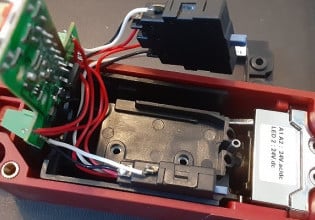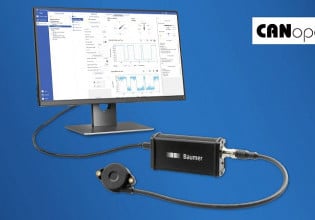New IE5 SynRM Liquid Cooled Motor From ABB Promises Reduced TCO
ABB has released a liquid-cooled motor that reduces the total cost of ownership (TCO) by greatly increasing efficiency, reducing weight, and adding flexibility to automation system design.
ABB’s newest synchronous reluctance motor, the IE5 SynRM, promises lower energy consumption and noise levels while boosting design flexibility for manufacturing centers. Key to the motor’s reduced energy use is its high-efficiency liquid cooling system, which keeps bearings and the rotor at a much cooler temperature than air cooling.

ABB’s new IE5 SynRM motor on display at a recent tradeshow. Image used courtesy of ABB
Advantages of Liquid Cooling
Liquid-cooled motors do not require fans or moving air near the motor. The liquid can be cooled elsewhere through a built-in heat exchanger, meaning a fan is not required. Moving air is often used to help cool motors, but it also generates noise and exhausts hot air that must be directed away from the motor. The liquid-cooled motors run much more quietly. Furthermore, automation systems can be designed without needing to worry about where the hot air must be directed.
Comparing IE3 Vs IE5 Motors
The IE3 motor was the leading design up until the IE5 was released. Compared to the IE3, the IE5 has 40% less energy lost. Because 97% of a motor’s TCO is in the energy required to run the motor, losing less energy to friction and heat is a significant advantage. The liquid-cooled system means lower bearing temperatures, leading to longer life and fewer stops for planned and unplanned maintenance.
Amazingly, the IE5 has a weight that is only about half as much as the IE3, yet it maintains the same footprint. This adds to the flexibility of the system, as it is easier to locate. Also, with no need to move hot air away from the motor, the IE5 has more flexibility in the orientation and mounting configuration. More of these motors can be placed in a small space without significantly raising the temperature of the space, due to all of the hot air being fanned away from the motors.
Upgrading from an IE3 to an IE5 often means a payback period of less than a year, due to the energy savings alone.
Target Markets
Rubber, plastic, as well as food and beverage manufacturers are often concerned about where to vent waste heat. Electric motors that generate waste heat raise the processing temperatures of the goods they are near, and all of the blowing, hot air can turn areas into a small convection oven.
Consider a chocolate manufacturer. In one operation, they melt nibs and add flavoring ingredients with a large, electric motor-driven mixer. They cannot place a packaging operation anywhere near this mixing operation, as the waste heat will melt the finished chocolate. This limits design flexibility. With a liquid-cooled motor, this is less of an issue.
Suppose a plastics plant requires several pumps, driven by electric motors, to run in parallel. As the temperature of each motor climbs, cooling of adjacent motors becomes less efficient. On a hot summer day, it is not uncommon for several thermal overload relays to open, due simply to inadequate cooling, delaying production. Once again, liquid-cooled motors are not blowing hot air on each other.
Bottom Line
With such a short payback period, reduced noise, and lower energy usage, these motors will be adopted rapidly in any heat-sensitive manufacturing operation. By being able to perform a 1:1 swap with the IE3, plenty of IE5s are doubtless destined to phase into existing production lines.






